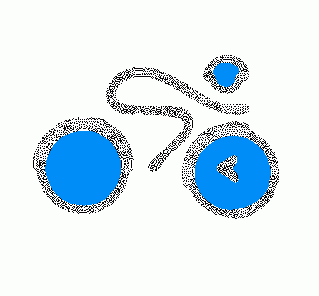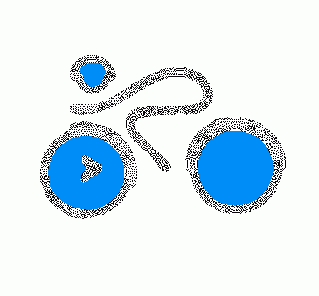| Newsletter - 2005 Archive |

|

|
Cycling Club |

|

|
| Newsletter - 2005 Archive |

|

|
Cycling Club |

|

|
Next--->
|
This is the counter argument for another newsletter submission: 40,000 vs 50,000 km: The Case for 100,000. 40,000 vs 100,000
km At the Spring Social there was some discussion of the life-time event distance awards that the club has been thinking about establishing. Michel was not unfair in his presentation of the issue, but only one side of this issue was explained and advocated. I'd like to take a moment to make the case for a 100,000 km standard rather than 40,000. I'm sure it hasn't escaped anyone's notice that the quality of work coming out of the BC Randonneur's pins, medals and awards department in recent years has been exceptional, with coordinator Karen Smith receiving valuable creative input from Michel Richard and Ali Holt. Normally when I hear that Michel and Karen have an idea for something I know we can relax in the comfortable knowledge that the result will exceed expectations. Michel's idea to use 40,000 km instead of 100,000 km as the bench mark for the life-time event distance award(s), is reluctantly parked in my mind as the exception that proves this rule. The idea of the award is pretty self apparent - it recognizes a rider who passes a big distance mark. But what should the distance or distances be? The idea of the 40,000 km figure is that
it is almost exactly the circumference of the earth. The figure
might give people a helpful perspective on the accomplishment.
The figure could be doubled to acknowledge a higher level of
achievement, and perhaps halved to acknowledge an entry level.
(The 100,000 km standard could similarly have several levels
if we wished - 50,000 and 25,000 km would be the logical level
breaks.) The proposed pin for the 40,000 km award includes a
map of the world. It must be acknowledged that the 100,000 km distance figure also has nothing to do with the achievement being celebrated, but the 100,000 figure doesn't need an explanatory footnote because it is a more expected, a more intuitive figure, and it wouldn't occur to anyone that the figure carried any special meaning. It is a number free of association. The proposed pin for the 40,000 km option, with the map of the world featured prominently, compounds the problem - someone looking at the award could not be faulted for assuming that world-wide brevet accomplishment is a part of what is being recognized, when the award could easily be earned without straying too far from BC's border. Why would we confuse what should be such an easily understood concept? Centennial celebrations, golden anniversary, mile high club, century-club... the round numbers resonate for us because that is the way our minds work. My feeling is that to brand an award off the expected grid, we need to have a particularly good reason - one that has a powerful and meaningful connection to our club or our sport. The measurement of the circumference of the world has no intrinsic meaning to either our club or our sport. It is in fact, a red herring and a distraction - it clouds the achievement, and I would argue, diminishes the award. I'm not crazy about the idea of any "special" number as the yardstick for this award, but if we were to take this path, maybe we should take a moment to consider what figures would make more sense? Are there numbers which make sense in the context of randonneur cycling? Two that come to mind are 25,000 kms, and 37,000. Ali Holt has suggested that 25,000 is the number you get by doing a super-sized brevet series 200-1000 km for a decade. 37,000 km is the number derived from the same principle, but including 1200s. If you look at the early annual distance totals for randonneurs in BC, a lot of 2500 and 3700 km pop off the page. [link]. Another figure that would have meaning is 50,000 km. It's the number you would get if you earned 10 Brevet Randonneur 5000 pins - perfect for a club focussed on achieving BR 5000 pins. Of course the most special number in our sport is arguably the arbitrary distance from Paris to Brest and back again - ~1200 km. A century of PBPs would be 120,000 km. I think a case could be made for all four
of these figures, but like the world circumference proposal,
there is still reason to pause. What they all have in common
is the fact that someone is telling us how we should be interpreting
the distance we have ridden. I'm not so sure we really want the
award interpreted for us at all - I'm not sure we want anyone
to dictate how we should understand our own personal achievement.
Choosing the neutral 100,000 km figure as the gold standard,
frees the achievement from other peoples' ideas about what our
achievement means. The distance is what it is, and not a shadow
of something else. April 2, 2005 |